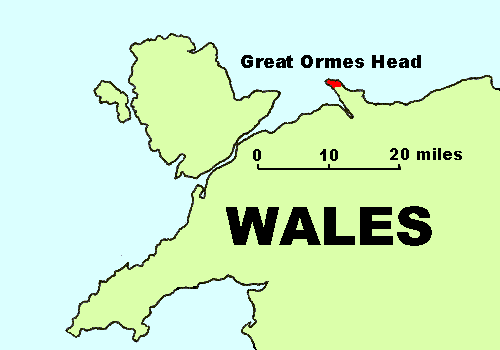

 |
|
The Great Ormeís Head, at Llandudno, is an isolated promontory of Carboniferous Limestone
that rises to nearly 225 meters above sea level. Great Orme Mines are situated within the
picturesque surroundings of the Great Orme Country Park only one mile from the center of
Llandudno. Copper has been mined here for 4,000 years and the site is the only Bronze Age
copper mine in the world open to the public.
There is a visitor center, open to non-mine visitors, with displays depicting life and times in the Bronze Age together with archaeological finds and artifacts. An audiovisual display sets the scene for your exploration of the underground workings. One section of the mine is open for visitors to see for themselves a small part of this vast underground mining complex. The tunnels eventually reach a point to view a large and impressive Bronze Age cavern. Numerous animal bones have been found in this cavern together with two human collar bones, which are now on display. Visitors can then walk around the prehistoric landscape uncovered in 1987 and look down the 470 foot Vivianís shaft that was used in the 19th century for both pumping water and winding up the ore. A small exhibition shows how our ancestors turned rock into metal. |
 |
|
Since excavations began in 1987, over 100,000 tons of waste from the 18th and 19th century mining
has been removed. This revealed entrances into the most extensive mines of the ancient
world. Four miles of tunnels have been surveyed that date from between 1860 BC and 600 BC.
Some are large enough to walk through while others are so small that very young children must
have mined them. A large cavern, about 13 meters high, 23 meters wide and 15 meters in depth
was mined over 3,500 years ago.
Bronze Age miners used volcanic beach stones as hammers and over 2,500 of these have been found. Loose and broken rock was then scraped away with a piece of animal bone. Of the 30,000 bones found in the mine about 80% are from cattle with the remainder from sheep, goats, deer and wild boar. Sometimes the miners lit fires against the rock which would crack after it was allowed to cool. Charcoal remains of trees indicate that forest management was practiced to supply the mine with wood. On the surface the copper ore was crushed and washed before being smelted in a clay kiln at a temperature of 1,100 degrees centigrade, reached by pumping air through burning charcoal with leather bellows. It has been estimated that up to 1,769 tons of copper metal was extracted from the Great Orme mine during the Bronze Age. Some of this copper was used for ornamental purposes but on its own is too soft for tools and weapons. Mixed with 10% tin, copper gives bronze; a tougher metal that can be poured into moulds and hardened by hammering with stone. Axes were probably the most commonly made bronze objects and the amount of metal extracted would have permitted the manufacture of over 10 million of them. It is quite possible that the Great Orme was producing such a surplus of copper that it might even have been exported outside of Britain. Perhaps the most remarkable aspect of this bronze production is that the tin must have come from Cornwall, involving a round trip of over 500 miles.
(Reference source: Wikipedia, the free encyclopedia )
|

|
Return to ORMISTON NAME page |
